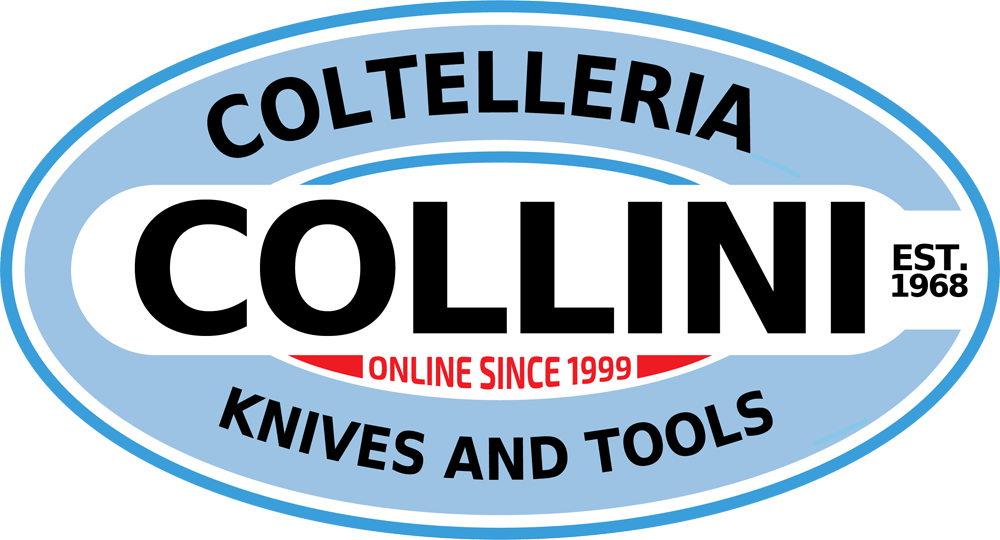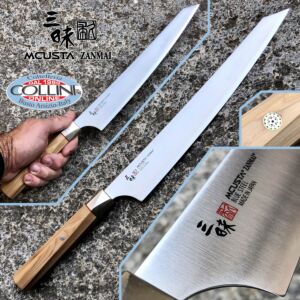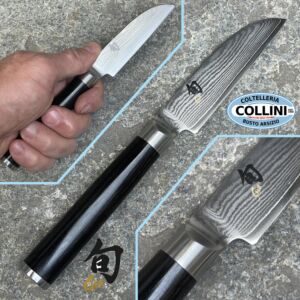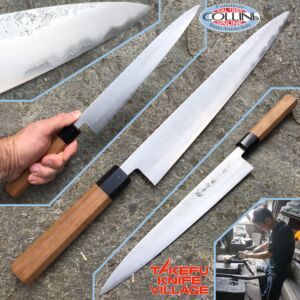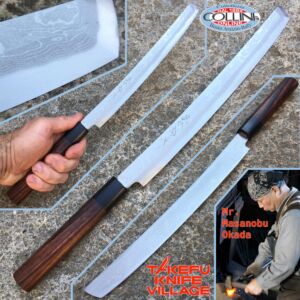Damascus Blade Kitchen Knives: Slice and Cook with Style and Elegance
-
Mcusta Zanmai - Beyond Sujihiki slicing knife 27cm - Aogami Super steel - ZBX-5011B - kitchen knife
The BEYOND series is the line of top-of-the-range professional knives produced by the Japanese MCUSTA ZANMAI for the year 2020.
The handles of the Beyond series are made of Hinoki wood and as per tradition have a decorative rivet with mosaic. The three-layer blade, with the two external stainless steel and the internal core in Aogami Super carbon (Super Blue Steel) is hardened to 62-63 HRC. Each knife is packaged in a wooden gift box with a bow.
Production: Semi-artisanal
Blade: 3-layer steel - stainless steel extrene plates, Aogami Super core (Super Blue carbon steel) 62-63 HRC
Handle: Hinoki wood
Blade length: 270 mm.
Blade thickness: 2 mm.
Total length: 432 mm
Weight: 180g.
Notes: not dishwasher safe
Packaging: elegant wooden boxSteel specifications:
Aogami Super (Hitachi Metals Ltd.) is one of the best Japanese carbon. In addition to containing more carbon, chromium and tungsten than Blue Steel, it also includes molybdenum. It has excellent cutting ability and excellent thread retention. Aogami Super is also capable of achieving high hardness without being brittle. Many knife enthusiasts consider Aogami Super to be one of the best high carbon steels in the world.
The city of Seki in Japan has been the center of producing the best Japanese blades since the mid-13th century. Natural choice thanks to its wealth of natural resources: sand, iron, coal and water, all important elements for the processing of blades. The techniques and skills of the ancient blacksmiths, handed down over the centuries, have currently been combined with modern technologies. The city of Seki still remains today the center of production of the best Japanese blades.
Mcusta knives are made in Seki and are the pinnacle of this synthesis between Japanese artisan tradition and modern technology. Each knife is assembled by hand, finished and checked by the craftsmen of the Mcusta team. Mcusta knives are considered among the best in the world!
Coltelleria Collini is the official distributor for Italy of MCUSTA Japanese knives
ZBX-5011B -
Kai Japan - Shun DM-0714 - Peeling Knife 85mm - kitchen knives
Shun Classic is one of the flagship lines of the Kai Group (which currently also includes the Kershaw and Zero Tolerance brands), a famous Japanese manufacturer of knives and razors since the early 1900s. This is a series of knives and kitchen accessories suitable for professionals and enthusiasts.
The blades are made from laminated steel consisting of an inner layer of VG-10 stainless steel and two outer cheeks of 32-layer damascus. The result is excellent cutting ability combined with excellent edge retention and good flexibility, which is also guaranteed by differentiated tempering.
These knives currently represent the top of Japanese culinary technology. However, the quality does not stop with just the steel used, but continues with the care of the workmanship (sharpening in particular) and the materials used, such as the splendid Pakkawood used for the handles.
Blade: 32-ply Damascus laminate and VG-10 stainless steel
Handle: black Pakkawood
Blade length: 85 mm.
Blade thickness: 2 mm.
Total length: 195 mm.
Weight: 65 g.
Notes: not dishwasher safeDM-0714 -
Kai Japan - Shun DM-0735 - Ham Slicer Knife 300mm - kitchen knives
Shun Classic is one of the flagship lines of the Kai Group (which currently also includes the Kershaw and Zero Tolerance brands), a famous Japanese manufacturer of knives and razors since the early 1900s. This is a series of knives and kitchen accessories suitable for professionals and enthusiasts.
The blades are made of rolled steel consisting of an inner layer of VG-10 stainless steel and two outer cheeks of 32-layer damask. The result is excellent cutting capacity combined with excellent edge retention and good flexibility, which is also guaranteed by the differentiated tempering.
Today, these knives represent the pinnacle of Japanese culinary technology. The quality does not stop at the steel used, however, but continues with the care taken in the workmanship (sharpening in particular) and the materials used, such as the splendid Pakkawood used for the handles.
Blade: VG-10 stainless steel - to ensure flexibility the damascus-rolled steel used on most models in this series was not used
Handle: Black Pakkawood
Blade length: 300 mm.
Blade thickness: 1 mm.
Total length: 440 mm.
Weight: 170 g.
Notes: not dishwasher safeDM-0735 -
Viper - Katla Knife by Vox - Damascus - Dark Matter Carbon Fiber - Limited Edition - VA5980FCM - Knife
Katla, designed by Jesper Voxnaes, is a liner lock folding knife, which brings back the Tanto profile blade with a bevel that enhances the excellent cutting qualities.
The rotation mechanism is provided by thrust bearings, and it can be opened with either the double thumb stud or the very fast flipper.
The detail that characterizes the Katla is the 3D processing of the handle at both ends of the bolster, which reinterprets in a modern way, the inlays of the classic Viper models.
The flat edges and the titanium clip allow for comfortable and discreet carry.
Intended use: EDC / Sport
Type of production: Industrial
Country of production: Italy
Blade: Super Dense Twist stainless Damascus
Blade finish: Satin
Handle: Dark matter carbon fiber
Blade length: 82mm.
Blade thickness: 4mm.
Closed length: 116mm.
Total length: 198mm.
Weight: 122g.
Lock: Liner Lock
Clip: Titanium
Packaging: Deluxe cardboard box with Viper logos
Notes: Design by Jesper Voxnaes - opening with Carson Flipper system on ball bearing - Damascus SSCT spacer - limited edition of 100 piecesVA5980FCM -
Takefu Village - Takobiki Knife 260mm by Mr. Masanobu Okada - F-276R - kitchen knife
Takefu Knives Village is a brand born in 1991 in Echizen Fukui, a city in Japan famous since 1400 for the production of knives.
The Takefu knives brand is based on the union of 10 local artisans who make each knife by hand.The model presented is made by:
Mr. Masanobu Okada
Born in the city of Echizen in 1949, the third generation of forging artisans, he is one of the few living heirs of the "masaoki-ho" typical of Echizen, a forging technique that consists in hammering and folding the steel giving it a rhomboid shape for get a thinner, sharper and easier to sharpen steel sheet.Initially specialized in the production of agricultural tools with the Monjiro brand, in recent times he began to produce artisanal kitchen knives with the traditional "uchi-hamono" technique, also receiving the title of Dentoukougeishi (traditional craftsman) after having undergone the strict examinations of the commission of the Traditional Crafts Industry Promotion Association Foundation.
The uchi-hamono technique (uchi means blow and hamono means cutting tool) finds its origins towards the end of the 1300s, in the Muromachi period and consists of manually beating with a hammer and repeatedly a heated steel sheet until a blade of cut. Many tools made with this particular method are still on permanent display at the MoMA (Museum of Modern Art) in New York.
In a recent interview Mr. Okada said: "I have been engaged with this art for over 45 years, but still today I still think that it is an infinite world where the notions learned never become obsolete and for this I feel I have to transmit them. to the younger generations ". Currently, under his careful guidance, two apprentices are thoroughly learning the blade polishing techniques.
Characteristics of the knife:Use: meat / fish
Blade: CladSteel carbon steel with cutting edge in White Paper Steel (Shirogami) at 62 / 64HRC and damascus with 67 layers
Provenance Lama: Japanese craftsmanship
Handle: SandalWood, very hard and water resistant wood
Packaging: in cardboard with Japanese writing
Blade length: 265mm
Total length: 410mm
Blade thickness: from 3.5mm to 3mm
Handle Length: 139mm
Weight: 178g* Not every knife is signed on the blade by the craftsman who made it
Maintenance:
Considering the high carbon steel used for the blade and the extreme construction quality of these knives, we recommend a series of attentions to be followed to maintain the quality of the product over time.- Never put the knife in the dishwasher
- Rinse the knife with hot water before first use
- Rinse the knife immediately after each use without aggressive dishwashing detergent and dry with a soft cloth (always starting at the back of the cutting edge)
- Aggressive foods such as lemon juice must be promptly rinsed immediately after use
- Do not use glass or granite plates as a cutting support. Use only wooden bases
- Pay attention that the cutting edge of the knife does not come into contact with other metal objects during its storage to avoid damage to the cutting edge.
Invia commenti
Cronologia
Salvate
CommunityF-276R -
Takefu Village - Sujihiki Knife 270mm by Mr. Kanehiro Kintaro - kitchen knife
Takefu Knives Village is a brand born in 1991 in Echizen Fukui, Japan's famous city since the 1400s for knives production.
The Takefu knives brand is based on the union of 10 local artisans who make every knife by hand.The model presented is made by:
Mr. Kanehiro Kintaro
Kanehiro-san knives have gained popularity among professional chefs for the highest construction level and the high performance and cutting performance.
Knife Features:Use: meat / fish
Blade: Clad Steel (Steel Hammer Forged, San Mai) Steel with Aogami cutting edge super carbon steel core 62 / 63HRC with 3 layers
Origin Knife: Japanese craftsmanship
Handle: Cherry wood
Packing: in cardboard with Japanese writing
Length Blade: 265mm
Total Length: 417mm
Thickness Blade: 4mm to 1mm
Length Grip: 137mm
Weight: 154g* Not every knife is signed on the blade by the craftsman who made it
Maintenance:
Considering the high carbon steel used for the blade and the extreme construction quality of these knives, we recommend a number of attentions to keep in order to maintain the quality of the product over time.- Never put the knife in the dishwasher
- Rinse the knife with hot water before first use
- Rinse the knife immediately after each use without detergent for aggressive crockery and dry with a soft cloth (always starting at the back of the blade wire)
- Aggressive foods such as lemon juice should be rinsed immediately after use
- Do not use glass or granite plates as a cutting support. Use only wooden bases
- Take care that the knife blade wire does not come into contact with other metallic objects during its storage to prevent damage to the blade.D-507 -
Takefu Village - Takobiki Knife 270mm by Mr. Masanobu Okada - kitchen knife
He was born in 1949 and is the 3rd generation of Okada Uchihamono. He is originally a blacksmith of gardening tools such as a sickle. In recent years, he has started to produce unique kitchen knife like your bought Takobiki. The Traditional Craftsman is the so-called Dentoukougeishi (Traditional Craftsman) which is the Accreditation Examination conducted by the Traditional Crafts Industry Promotion Association Foundation in accordance with Section 8 of Section 24 of the Act on Promotion of Traditional Craft Industries
Knife Features:
Use: meat / fish
Blade: CladSteel carbon steel with 62 / 64HRC White Paper Steel (Shirogami) cutting edge and 33-layer Damask "Suminagashi"
Origin Knife: Japanese craftsmanship
Handle: SandalWood, very hard and water resistant
Packing: in cardboard with Japanese writing
Length Blade: 265mm
Total Length: 410mm
Thickness Blade: 3.5mm to 3mm
Length Grip: 139mm
Weight: 162gF-416 -
Takefu Village - Yanagiba Sashimi Knife 270mm by Mr. Hideo Kitaoka - kitchen knife
Mr. Hideo Kitaoka
He was born in 1950 and is the 3rd generation of Kitaoka Hamono. He has been a specialist of Kataba (single-beveled) knife from the beginning. He is also Dentoukougeishi.Use: meat / fish
Blade: CladSteel carbon steel with 62 / 64HRC White Paper Steel (Shirogami) cutting edge and 33-layer Damask "Suminagashi"
Origin Knife: Japanese craftsmanship
Handle: SandalWood, very hard and water resistant
Packing: in cardboard with Japanese writing
Length Blade: 257mm
Total Length: 410mm
Thickness Blade: 4mm to 1.5mm
Length Grip: 139mm
Weight: 184g* Not every knife is signed on the blade by the craftsman who made it
C-804
